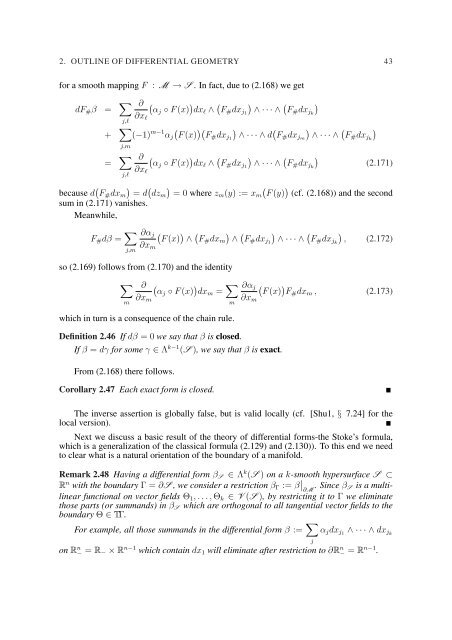EQUATIONS OF ELASTIC HYPERSURFACES
EQUATIONS OF ELASTIC HYPERSURFACES
EQUATIONS OF ELASTIC HYPERSURFACES
You also want an ePaper? Increase the reach of your titles
YUMPU automatically turns print PDFs into web optimized ePapers that Google loves.
2. OUTLINE <strong>OF</strong> DIFFERENTIAL GEOMETRY 43<br />
for a smooth mapping F : M → S . In fact, due to (2.168) we get<br />
dF # β = ∑ j,l<br />
+ ∑ j,m<br />
∂ (<br />
αj ◦ F (x) ) dx l ∧ ( ) ( )<br />
F # dx j1 ∧ · · · ∧ F# dx jk<br />
∂x l<br />
(−1) m−1 α j<br />
(<br />
F (x)<br />
)(<br />
F# dx j1<br />
)<br />
∧ · · · ∧ d<br />
(<br />
F# dx jm<br />
)<br />
∧ · · · ∧<br />
(<br />
F# dx jk<br />
)<br />
= ∑ j,l<br />
∂ (<br />
αj ◦ F (x) ) dx l ∧ ( ) ( )<br />
F # dx j1 ∧ · · · ∧ F# dx jk<br />
∂x l<br />
(2.171)<br />
because d ( F # dx m<br />
)<br />
= d<br />
(<br />
dzm<br />
)<br />
= 0 where zm (y) := x m<br />
(<br />
F (y)<br />
)<br />
(cf. (2.168)) and the second<br />
sum in (2.171) vanishes.<br />
Meanwhile,<br />
F # dβ = ∑ j,m<br />
∂α j<br />
∂x m<br />
(<br />
F (x)<br />
)<br />
∧<br />
(<br />
F# dx m<br />
)<br />
∧<br />
(<br />
F# dx j1<br />
)<br />
∧ · · · ∧<br />
(<br />
F# dx jk<br />
)<br />
, (2.172)<br />
so (2.169) follows from (2.170) and the identity<br />
∑<br />
m<br />
∂<br />
∂x m<br />
(<br />
αj ◦ F (x) ) dx m = ∑ m<br />
∂α j<br />
∂x m<br />
(<br />
F (x)<br />
)<br />
F# dx m , (2.173)<br />
which in turn is a consequence of the chain rule.<br />
Definition 2.46 If dβ = 0 we say that β is closed.<br />
If β = dγ for some γ ∈ Λ k−1 (S ), we say that β is exact.<br />
From (2.168) there follows.<br />
Corollary 2.47 Each exact form is closed.<br />
The inverse assertion is globally false, but is valid locally (cf. [Shu1, § 7.24] for the<br />
local version).<br />
Next we discuss a basic result of the theory of differential forms-the Stoke’s formula,<br />
which is a generalization of the classical formula (2.129) and (2.130)). To this end we need<br />
to clear what is a natural orientation of the boundary of a manifold.<br />
Remark 2.48 Having a differential form β S ∈ Λ k (S ) on a k-smooth hypersurface S ⊂<br />
R n with the boundary Γ = ∂S , we consider a restriction β Γ := β ∣ ∂M<br />
. Since β S is a multilinear<br />
functional on vector fields Θ 1 , . . . , Θ k ∈ V (S ), by restricting it to Γ we eliminate<br />
those parts (or summands) in β S which are orthogonal to all tangential vector fields to the<br />
boundary Θ ∈ TΓ.<br />
For example, all those summands in the differential form β := ∑ j<br />
α j dx j1 ∧ · · · ∧ dx jk<br />
on R n − = R − × R n−1 which contain dx 1 will eliminate after restriction to ∂R n − = R n−1 .

















